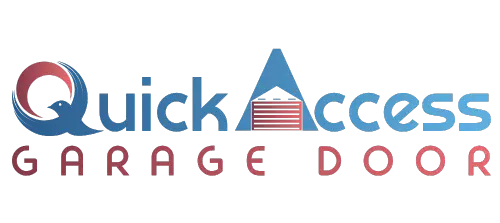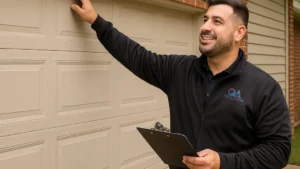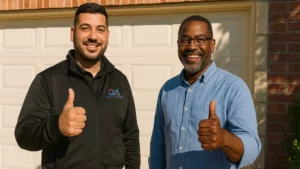Essential Garage Door Safety Tips for Families!
Ensuring optimal garage door safety is paramount for every household, especially those with children and pets. Your garage door is likely the largest and heaviest moving object in your home, and understanding its operation and potential hazards is the first step towards preventing accidents. This comprehensive guide provides essential garage door safety tips tailored for families in the Dallas, TX area, helping you create a safer environment around this crucial home feature. We often overlook the potential risks associated with automatic garage doors until something goes wrong. Proactive awareness and regular checks are key components of reliable garage door safety.
From understanding the vital safety mechanisms like photo-eye sensors and auto-reverse functions to teaching children about the dangers, implementing robust garage door safety practices is non-negotiable. Remember, a moment’s lapse in attention can lead to serious injury. Let’s explore the practical steps you can take to enhance garage door safety in your home, ensuring peace of mind for your entire family. Following these guidelines contributes significantly to overall home safety.
Understanding Your Garage Door’s Safety Features
Modern automatic garage door systems come equipped with several critical safety features designed to prevent entrapment and injury. Familiarizing yourself with these is fundamental to garage door safety. The two most important are the photoelectric sensors (photo eyes) and the auto-reverse mechanism. Proper function of these systems is vital for everyday garage door safety.
Photoelectric Sensors (Photo Eyes)
Located near the bottom of the door tracks (usually no more than 6 inches above the floor), these sensors project an invisible beam across the garage door opening. If anything breaks this beam while the door is closing, the door should immediately stop and reverse direction. This is a cornerstone of modern garage door safety, specifically designed to protect children and pets who might dart under a closing door. Regularly testing these sensors is a critical aspect of maintaining garage door safety. To test them, start closing the door and then wave an object (like a broom handle or even your foot – carefully!) through the beam. The door must reverse. If it doesn’t, the sensors may be misaligned, dirty, or malfunctioning, compromising your garage door safety. Contact a professional like Quick Access Garage Door Repair immediately if they fail the test. According to the Consumer Product Safety Commission (CPSC), functional safety sensors are crucial.
Auto-Reverse Mechanism (Contact Reversal)
In addition to the photo eyes, your garage door opener has a built-in force setting and contact reversal system. If the closing door encounters an obstruction (like an object left in its path that the photo eyes didn’t detect), it should automatically reverse upon contact. This mechanical aspect of garage door safety provides a secondary layer of protection. You can test this monthly. Place a non-collapsible object, like a roll of paper towels or a sturdy block of wood (about 1.5 inches high), flat on the ground in the door’s path. When the closing door touches the object, it should promptly reverse. If it fails to reverse or requires excessive force before doing so, the force setting needs adjustment, or the opener might require service. Neglecting this test compromises essential garage door safety. Refer to your opener’s manual for adjustment instructions, but if you’re unsure, professional help ensures proper garage door safety calibration.
Manual Emergency Release
Every automatic garage door opener has a manual release mechanism, usually a red cord hanging from the opener track. Knowing how to use this is vital for garage door safety during power outages or opener malfunctions. Pulling this cord disconnects the door from the opener, allowing you to operate it manually. Ensure everyone in the family who is old enough understands how and when to use it. However, caution is advised: if the door springs are broken or unbalanced, the door could slam shut unexpectedly when released, posing a significant hazard. This underscores the importance of regular professional inspections for complete garage door safety. Only use the manual release when the door is fully closed if possible, unless it’s an emergency.
Teaching Children About Garage Door Safety
Children are naturally curious, and a moving garage door can seem like a fascinating toy. Establishing clear rules and educating them about the dangers is crucial for child safety garage door awareness and overall garage door safety. Never underestimate a child’s ability to find themselves in a dangerous situation quickly.
- Hands Off: Teach children that the garage door and its parts (opener, tracks, springs, cables, remote controls) are not toys. They should never hang onto a moving door or race underneath it as it closes. Emphasize that this is a fundamental rule of garage door safety.
- Wall Control Placement: Install the garage door wall control button out of reach of small children (at least five feet from the floor) and where you have a clear view of the door. This simple placement significantly enhances garage door safety.
- Remote Controls & Codes: Keep remote controls and keypads away from children. Teach them not to play with remotes. Also, keep your garage door opener access code secret and never share it. Unauthorized access compromises both security and garage door safety.
- Watch Fingers and Toes: Explain the danger of pinch points between door sections and near tracks. Teach children to keep their fingers and hands away from these areas at all times. This is a critical lesson in practical garage door safety. Safe Kids Worldwide offers resources on discussing home safety with children.
- Supervision is Key: Never leave young children unattended in the garage, especially when the door is operating. Constant supervision is the best guarantee of child safety garage door adherence and overall garage door safety.
“An ounce of prevention is worth a pound of cure.” – Benjamin Franklin
This famous quote perfectly encapsulates the essence of proactive garage door safety. Taking preventative measures is far better than dealing with the consequences of an accident. Implementing these garage door safety steps requires diligence but pays dividends in family well-being.
Garage Door Safety At-a-Glance
Test Sensors Monthly
Ensure photo eyes & auto-reverse work correctly. This simple check is vital for garage door safety.
Keep Kids Away
Teach children the door isn’t a toy. Remotes & controls out of reach ensures child safety garage door rules.
Visually Inspect Often
Look for worn springs, frayed cables, or damaged rollers. Early detection improves garage door safety.
Professional Maintenance
Annual inspections by pros like Quick Access Garage Door ensure peak automatic garage door safety.
Advanced Garage Door Safety Considerations
Beyond the basics, several other factors contribute to comprehensive garage door safety. Considering these situations and components can further minimize risks for your family. Maintaining vigilance about garage door safety includes understanding less common, but still important, scenarios.
Power Outages and Manual Operation
As mentioned, the manual release is crucial during power outages. However, lifting a heavy garage door manually can be strenuous and potentially dangerous if the door isn’t properly balanced or if springs are worn. An improperly balanced door can feel extremely heavy or fly up too quickly, compromising garage door safety. If you struggle to lift the door manually, it’s a sign that the springs may need professional attention from a service like Quick Access Garage Door Services. Never attempt to force a stuck door. Ensuring you can safely operate the door manually is part of overall preparedness and garage door safety.
The Danger of Springs and Cables
Garage door springs (torsion or extension) and cables are under extreme tension. They do the heavy lifting, counterbalancing the door’s weight. A snapping spring or cable can cause the door to fall rapidly and can send metal fragments flying with incredible force. This is one of the most significant risks related to garage door safety. Homeowners should **never** attempt to adjust, repair, or remove springs or cables themselves. This work requires specialized tools and knowledge and should only be performed by trained professionals. Visual inspection is fine – look for rust or fraying – but leave repairs to experts to maintain garage door safety. The potential for severe injury is simply too high for a DIY approach.
Regular Visual Inspections
Make it a habit to visually inspect your garage door system monthly. Look at the tracks, rollers, hinges, springs, and cables. Are the tracks clear of debris? Are rollers worn or cracked? Do hinges look secure? Is there visible rust or damage on springs or cables? Catching minor issues early can prevent major failures and uphold garage door safety. Listen to the door as it operates – grinding or scraping noises often indicate a problem that needs attention. Consistent visual checks are a simple yet effective part of proactive garage door safety management. Resources like the Family Safety & Health Magazine often highlight the importance of routine home checks.
Understanding Pinch Points
Modern garage doors often feature pinch-resistant panel designs, but older doors may not. The joints between door sections can create severe pinch hazards, especially for small fingers. Again, teach everyone, especially children, to keep hands and fingers away from moving door sections. Reinforce this aspect of child safety garage door rules frequently. Even with pinch-resistant designs, caution is always the best policy for maintaining garage door safety.
Security and Access Codes
While focusing on physical safety, don’t forget security. Treat your garage door remote like a house key. Don’t leave it visible in your car. Use rolling code technology if your opener supports it, which changes the access code each time you use the remote, preventing code grabbing. Regularly update keypad codes and only share them with trusted individuals. Good security practices are intertwined with overall garage door safety and home protection. Keeping access secure enhances peace of mind regarding automatic garage door safety.
“The safety of the people shall be the highest law.” – Marcus Tullius Cicero
Cicero’s ancient wisdom reminds us that protecting our loved ones is a fundamental responsibility. Applying this principle to modern conveniences like automatic garage doors means prioritizing garage door safety through awareness, maintenance, and education. Investing time in garage door safety is investing in your family’s well-being. Don’t neglect this crucial area of home safety.
Essential Garage Door Maintenance Tips
Taking Action: Professional Help and Real-World Scenarios
While homeowner awareness and basic maintenance are crucial first steps, there are times when professional expertise is essential for ensuring robust garage door safety. Recognizing when to call for help is as important as performing the monthly checks. Furthermore, understanding how these safety measures play out in real life reinforces their importance. Improving your home’s garage door safety often requires expert intervention.
When to Call the Professionals
Don’t hesitate to contact a qualified garage door technician if you encounter any of the following issues. Attempting complex repairs yourself can worsen the problem or lead to serious injury, completely undermining your garage door safety efforts:
- Failed Safety Tests: If your photo eyes or auto-reverse mechanism consistently fail tests, call for service immediately. This is non-negotiable for garage door safety.
- Broken Springs or Cables: As mentioned, these are under high tension. Never attempt DIY repair. Call Quick Access Garage Door Repair at 972-972-9302 for safe, professional replacement. Proper repair is vital for continued garage door safety.
- Damaged Door Panels: Bent or significantly damaged panels can affect the door’s movement and balance, impacting garage door safety. See about panel replacement options.
- Off-Track Door: A door that has come off its tracks is dangerous and immobile. Do not try to force it. Professional realignment is needed to restore function and garage door safety.
- Loud Noises or Jerky Movement: Unusual sounds often signal underlying problems with rollers, tracks, or the opener itself. Addressing these early maintains smooth operation and automatic garage door safety.
- Annual Maintenance: Even if everything seems fine, an annual professional inspection and tune-up is highly recommended. Technicians can spot potential issues you might miss, ensuring long-term reliability and optimal garage door safety. Learn more about our commitment to service.
Case Study: The Johnson Family’s Close Call
The Johnson family in Dallas recently had a startling experience that highlighted the importance of diligent garage door safety. While playing near the garage, their young son, Leo, accidentally left his tricycle partially in the path of the closing garage door. Thankfully, Mrs. Johnson had diligently performed the monthly safety sensor test just the week before.
As the door descended, the photo eye beam was broken by the tricycle’s handlebars. Instantly, the door stopped its downward movement and reversed back up. Leo was unharmed, and the tricycle only had a minor scratch. Mrs. Johnson realized that if the sensors hadn’t been working, the heavy door could have crushed the tricycle and potentially caused a much more serious situation if Leo had been closer. This incident reinforced their commitment to regular checks and taught their older children a valuable lesson about keeping the doorway clear – a crucial aspect of child safety garage door rules and overall garage door safety.
Outcome:
- Potential accident averted due to functional safety sensors.
- Reinforced family rules about keeping the garage door path clear.
- Highlighted the real-world value of routine garage door safety checks.
Prioritize Your Family’s Garage Door Safety Today!
Don’t wait for a close call like the Johnsons’. Ensure your garage door operates safely and reliably. Regular checks and professional maintenance are key to peace of mind and robust garage door safety.
If you’re in the Dallas, TX area and have concerns about your garage door safety, notice unusual noises, or haven’t had a professional inspection in over a year, contact the experts at Quick Access Garage Door Repair.
Or, visit our website to learn more about our garage door services and schedule an appointment online. Let us help you ensure top-notch garage door safety for your home!
Final Thoughts on Maintaining Family Garage Door Safety
Creating a safe home environment requires ongoing attention, and garage door safety is a critical component that should never be overlooked. By understanding the mechanisms, performing regular checks, teaching children the rules, and knowing when to call for professional help, you significantly reduce the risk of accidents. Remember that consistent focus on garage door safety protects your most valuable assets – your family members.
The automatic garage door is a marvel of convenience, but its size and power demand respect. Treat it with the seriousness it deserves. Make garage door safety checks a regular part of your home maintenance routine, just like checking smoke detectors. This diligence contributes significantly to overall family home safety. Don’t assume everything is fine; verify it through testing. This proactive approach is the hallmark of responsible homeownership and essential garage door safety.
Encourage all members of your household to be aware of the potential dangers and to follow the established safety rules. Open communication about risks and procedures enhances everyone’s understanding and commitment to garage door safety. A shared understanding fosters a safer environment for everyone. Make child safety garage door rules clear and non-negotiable.
“Safety brings first aid to the uninjured.” – F.S. Hughes
This quote serves as a powerful reminder that the ultimate goal of garage door safety is prevention. By implementing these tips and seeking professional assistance from trusted experts like Quick Access Garage Door Repair when needed, you are actively preventing injuries before they happen. Your commitment to garage door safety is an investment in your family’s continued health and well-being in your Dallas home. Stay vigilant, stay informed, and prioritize garage door safety always.
Remember, maintaining optimal automatic garage door safety is a continuous process, not a one-time task. Stay informed about new technologies and safety recommendations from organizations like the National Safety Council. Your ongoing commitment ensures lasting garage door safety for years to come.
Frequently Asked Questions About Garage Door Safety
Additional Resources & Further Reading:
- National Safety Council (NSC) – Broad home safety resources.
- Safe Kids Worldwide – Focus on preventing childhood injuries.
- Consumer Product Safety Commission (CPSC) – Product safety standards and recalls.
- Family Safety & Health Magazine (NSC) – Articles on family wellness and safety.
- Ready.gov – Home preparedness and safety information.
- U.S. Fire Administration (USFA) – Home fire safety, often overlapping with general safety.
Hashtags: #GarageDoorSafety #FamilySafety #HomeSafety #Dallas #GarageDoorRepair #ChildSafety #GarageDoorMaintenance #AutomaticGarageDoor #QuickAccessGarageDoor #SafetyTips #PreventAccidents #HomeMaintenance
Legal Disclaimer:
The information provided in this article is intended for general informational purposes only. While we strive to provide accurate and up-to-date information, Quick Access Garage Door Repair makes no representations or warranties of any kind, express or implied, about the completeness, accuracy, reliability, suitability, or availability with respect to the content. Any reliance you place on such information is therefore strictly at your own risk. Performing garage door maintenance or repairs can be dangerous. For complex issues, especially those involving springs, cables, or automatic openers, always consult a qualified professional technician. Quick Access Garage Door Repair is not liable for any injuries or damages resulting from attempts to perform repairs or maintenance based on this information. Always prioritize garage door safety by seeking expert help when needed. Contact Quick Access Garage Door Repair at 972-972-9302 for professional service in the Dallas, TX area.





